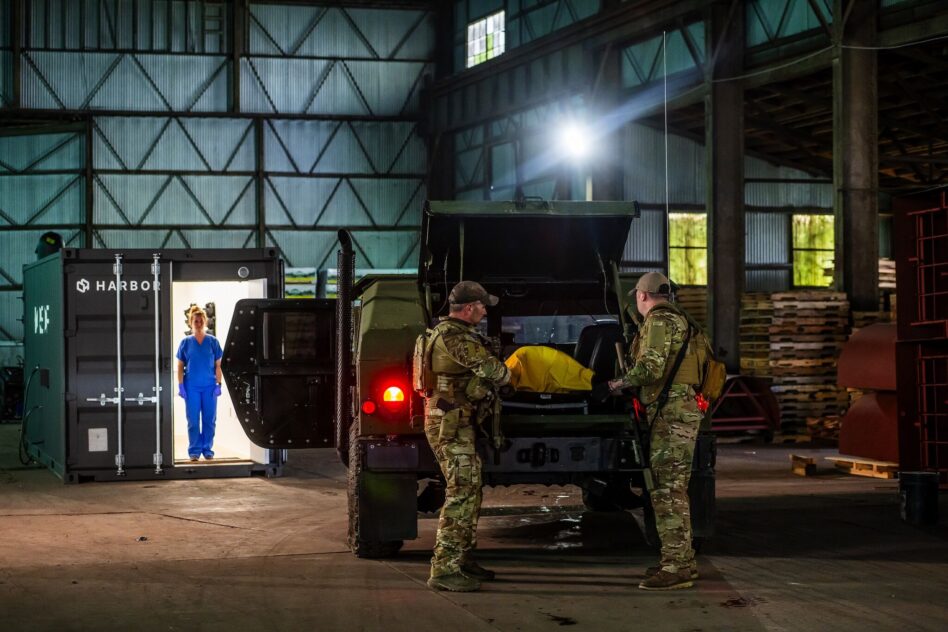If you thought startups were running out of Lord of the Rings-themed names, think again. Last week, a startup called Valinor—led by former Palantir exec Julie Bush—emerged from stealth with guns blazing and a clear mission: to build the ultra-necessary “picks and shovels” of defense tech, rather than chasing flashier “moonshots.”
We love a little limelight on the unsexy side of things.
Hit the ground running: When we say guns blazing, we mean it. In the week since coming out of stealth, Valinor has unveiled two innovative—albeit pretty unrelated—technologies in quick succession:
- Harbor: A self-contained, mobile, and software-focused hospital operating room housed in a ballistic and electronic warfare-hardened 20-foot storage container. Harbor can be configured for battlefield care ranging from resuscitation to surgeries and prolonged casualty care. The whole thing runs on bespoke HarborOS software, integrating medical sensors, computing power, and comms, as well as Anduril’s Lattice.
- Dispatch: A mobile drone charging station that can be plugged into different military platforms in remote operational environments. The first version is designed for the Army’s Short Range Reconnaissance (SRR) program and can charge drones like Skydio’s X10D or the Teal Drone Black Widow. Two of these stations were integrated onto Rheinmetall’s OX UGV at AUSA.
All gas: Over the next few weeks, the startup plans to roll out three more products:
- Streamline: A secure data capture tool designed for disconnected environments and distributed teams.
- Reflex: A next-generation smart optics system with advanced vision models that “embeds intelligence at the point-of-capture.”
- Condor: An attritable air- and ground-launched aerial system engineered for autonomous navigation, stabilization, and return-to-base operations.
Hub and spokes: If those products seem a little random, that’s the point. There’s a method to this madness. The company is structured as an “operational holding company” with a central “hub” that provides go-to-market, financing, prototyping infrastructure, and legal help to its “spokes,” the subsidiary companies focused on individual products.
The subsidiary product companies and their employees, in turn, have more autonomy over the engineering and product development, allowing them to focus on building the technologies, leaving the boring stuff to the hub–Valinor’s central team.
Making the unsexy sexy: “We don’t see our technologies as isolated, but instead as problems that often are overlooked in favor of flashier moonshots,” a company spokesperson told Tectonic via email. “Our unique structure allows us to go after these unaddressed problems at scale.”
“All Valinor products begin with credible, concrete demand signal,” they added. “Whether it’s coming directly from conversations with the government or with ecosystem partners, we always begin with a known, painful gap, and then work backwards to figure out the best solution to fill that space.”
If that sounds a lot like the Red Cell Partners incubation model, that’s not a coincidence—Red Cell founder and CEO Grant Verstandig is a founding partner, along with Founders Fund’s Trae Stephens and General Catalyst’s Paul Kwan.
Reinvent the wheel: The “hub and spokes” model makes a lot of sense, but it also comes with some tradeoffs and risk.
“An obvious downside to decentralization can be the lack of context sharing regarding lessons learned,” the spokesperson told Tectonic.”If each team is sprinting at their own problems, how do we ensure that common issues are avoided and engineering best practices are maintained? This is where the centralized operational resources from the Hub are critical.”
Despite that challenge, Valinor is feeling good about its hot start and where its unique structure can take it. Plus, there’s all the new tech to be excited about. Looking forward, Valinor says it has two main goals for the next year:
- Accelerating impact and growing its existing product companies (the total team now numbers 30 employees).
- Scaling its infrastructure to support more than a dozen product companies within the Valinor ecosystem.
Pretty ambitious, if we do say so ourselves. But if we’ve learned one thing from Anduril and Palantir, it’s that betting against Lord of the Rings fans is never a good idea.

